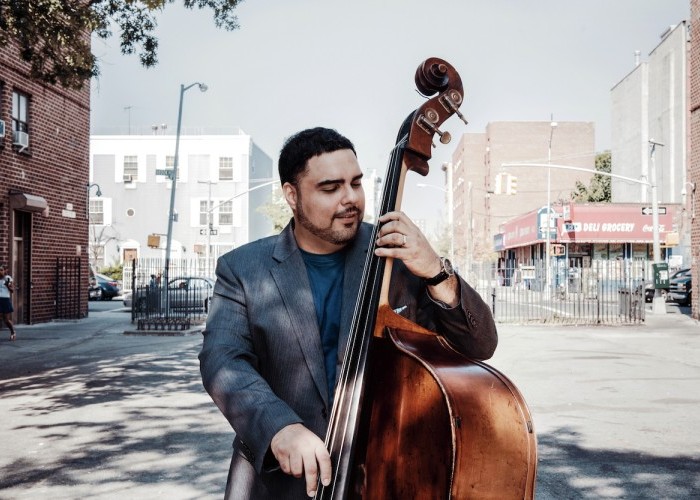Oct 28, 2025 10:47 AM
In Memoriam: Jack DeJohnette, 1942–2025
Jack DeJohnette, a bold and resourceful drummer and NEA Jazz Master who forged a unique vocabulary on the kit over his…

Bassit Carlos Henriquez has recorded The South Bronx Story, both live and in the studio, and RodBros Music is set to issue the material later this year.
(Photo: Lawrence Sumulong)He recalled getting his first bass—an Ampeg baby bass preferred by players on the salsa/Latin jazz scene—when he was 12 or 13 years old. “I had a bass teacher named Victor Venegas, who worked with Cal Tjader and Mongo Santamaría. He lived in Hunts Point, and I used to go there and hang with him and check out music. Victor drove me out to New Brunswick, New Jersey, in his blue Volvo to buy my first baby bass. In fact, I had a church tax-exempt form, which the pastor signed, so I didn’t have to pay taxes on it. The church actually gave me the money for the bass—$800. And then my mom gradually paid it back.”
Venegas soon introduced young Henriquez to Joe Santiago, a bassist who had played with Machito. “Both [Venegas and Santiago] fell in love with my total devotion to music, and they wanted to help me,” Henriquez recalled. “They gave me all the tools I needed.”
Santiago would pick Henriquez up at junior high school and take him out to lunch, before making the rounds with his young charge. “Basically, I was cutting class to hang with Joe. He would pick me up at noon, I would have lunch with him, and then he would give me an hour bass lesson. Then he would take me to Mario Bauzá’s house. We’d hang out with Mario and [Machito’s sister, the vocalist] Graciela. And then we would go hang with [conguero] Patato Valdés a bit before he finally took me home. It’s crazy ... all the cats I used to see back then. And that was an important part of my education.”
Venegas introduced Henriquez to Fort Apache Band bassist Andy Gonzalez and to New York Philharmonic bassist John Schaeffer, with whom Henriquez ended up studying for 15 years. “All these great bass players were my teachers. They gave me the knowledge of this music, the historical references and the key to understanding it. And they spoke about this music as the Holy Grail, which was inspiring to me. It all gave me the feeling that music was a higher calling.”
Today, as a 40-year-old father and resident of West Orange, New Jersey, Henriquez prizes his musical upbringing and cherishes the moments he spent with his South Bronx mentors.
“You can read a book about the history of this music, but if you hear it from somebody directly and you see how passionate they are about it, it registers a lot deeper. I’ve passed on many stories myself about playing with Tito Puente, Eddie Palmieri, Tito Nieves. Those stories are very important to tell. Sure, the music gets recorded, and we have all of those great albums to check out, but also it’s important to know, ‘Who was this person? What was he like?’ I think being a part of that oral tradition is fundamental in the development of any young musician.” DB

Jack DeJohnette boasted a musical resume that was as long as it was fearsome.
Oct 28, 2025 10:47 AM
Jack DeJohnette, a bold and resourceful drummer and NEA Jazz Master who forged a unique vocabulary on the kit over his…

D’Angelo achieved commercial and critical success experimenting with a fusion of jazz, funk, soul, R&B and hip-hop.
Oct 14, 2025 1:47 PM
D’Angelo, a Grammy-winning R&B and neo-soul singer, guitarist and pianist who exerted a profound influence on 21st…

To see the complete list of nominations for the 2026 Grammy Awards, go to grammy.com.
Nov 11, 2025 12:35 PM
The nominations for the 2026 Grammy Awards are in, with plenty to smile about for the worlds of jazz, blues and beyond.…

Drummond was cherished by generations of mainstream jazz listeners and bandleaders for his authoritative tonal presence, a defining quality of his style most apparent when he played his instrument unamplified.
Nov 4, 2025 11:39 AM
Ray Drummond, a first-call bassist who appeared on hundreds of albums as a sideman for some of the top names in jazz…

Jim McNeely’s singular body of work had a profound and lasting influence on many of today’s top jazz composers in the U.S. and in Europe.
Oct 7, 2025 3:40 PM
Pianist Jim McNeely, one of the most distinguished large ensemble jazz composers of his generation, died Sept. 26 at…





